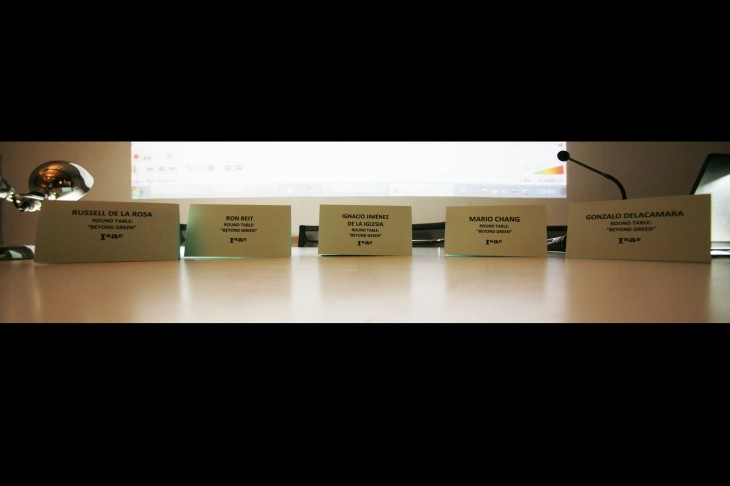This evening IAAC had the pleasure of hosting the IAAC Round Table BEYOND GREEN Sustainable 21st Century Global Cities, with the Participation of Ron Beit (Newark Real Estate Board member – RBH Group, USA), Ignacio Jiménez de Laiglesia (Real Estate developer – “Valencia Litoral”, Spain), Mario Chang (Strategic Advisor, USA), Russel De La Rosa (Derosa group architects, Project architect for Four Corners Millenium, part of SOMA Village, USA), and moderated by: Gonzalo Delacámara.
Gonzalo kicked off the debate with some reflections on the future of cities in the 21st Century. How do we find solutions to the problematics posed by these cities?
Beyond green is a reflection on the future of sustainable habitats, sustainability being something that is complex in nature, not unidimentional. Can the answer be in the buildings themselves? Or are we facing a more complex situation?
Dense cities seem to provide a more efficient solution with regards to energy consumption, for example Detroit is much less efficient that a city like Munich.
With reference to the Project of Newark, then presented by Ron Beit, it seems that the city aims to become more global in order to finally enrich its local experience. How can one connect the city of Newark to the world? What makes this city so special?
Also, in the context of finacial vs economic profitability, how can we make compatible development programs and economic profit? and how does this relate to the current macro economic context?
The word was then passed to Ron Beit who presented the Newark project. Newark, New Jersey, is the 3rd oldest city in the States, and offers what seems to be a better connection infrastructure in comparison to Manhattan. What made Newark so attractive in the begining was the quantity of problems that the city had, that could be transformed into potential opportunities. On top of this, the city was big enough to get attention, but small enough to offer the possibility of dealing with its problems. The general public was all for the redevelopment, as the policies and politics up until there applied in Newark were so bad, that the redevelopment was for sure beneficiary.
The project englobes the historic core of the city, a blank canvas to be redeveloped, not only to a scale of regional acceptance, but also to that of global acceptance, thanks to its strategic position on the grid of both regional and global infrastructural connections.
Newark, along side the infrastructural network it offered, also offered the great potential of a good university system.
The project revolves around 2 macro policies: the concentration of middle income housing stock, something which Manhattan does not offer; and the need to generate a community over night, so as to generate both a green and economicly sustainable, resolving the iminent social problems. To do so, they maintained the development plan horizontal, having buildings that are no more than 6 storeys high, and offering residential, retail and office buildings, generating a mixed use scenario and guaranteeing presence in the city 24/7. This allows for the generation of character in the streets of Newark.
The first phase of the project consisted in the Teachers village, offering low rent residencies, also for teachers, and new schools, so as to become a tool for the city to recruit and retain the best possible educators.
The neighborhood is one of the few with the LEED neighborhood development status.
Ignacio Jiménez de Laiglesia then presented the Valencia riverside and waterfront development. The city of valencia also presented, as Newark, bad policies, on top of which the recent bursting of the real estate bubble.
The lack of link between the city and its waterfront, is a problem that is still looking to be solved today, and with the window of opportunity presented by the Americas cup, seems to be the perfectopportunity to offer solutions to all the conflict present from a social and environmental point of view. The past expansion of the port area was done without any sensibility towards the surroundings, on top of which the river bed of the city generated a situation of ecological fragility.
The starting point for the redevelopment was therefore the port area, and its connections to the waterfront and the riverside, with the insertion of residential and commercial activities, generating a living and vibrant place, and offering, through a public-private project, both public and private amenities even in the old port area, a project thought for the creative society.
The discussion then commenced with all the members of the round table posing questions and rflecting around themes regarding the 21st Century city:
Most of the time, when an urban development plan is developed, a contingency plan is also developed, but what happens when a plan is successful?
Developers should think beyond just the bricks they are building, they should think more towards what they can give a community.
Cities need to become 24/7 use areas, with 24/7 communities, following the model of European cities.
Generating a global city, brings with it the global citizens, generating organic growth thanks to global connectivity.
The way that the younger generation is using the city is changing, calling for a change in the way we design cities: oreintated design for long term sustainability.

